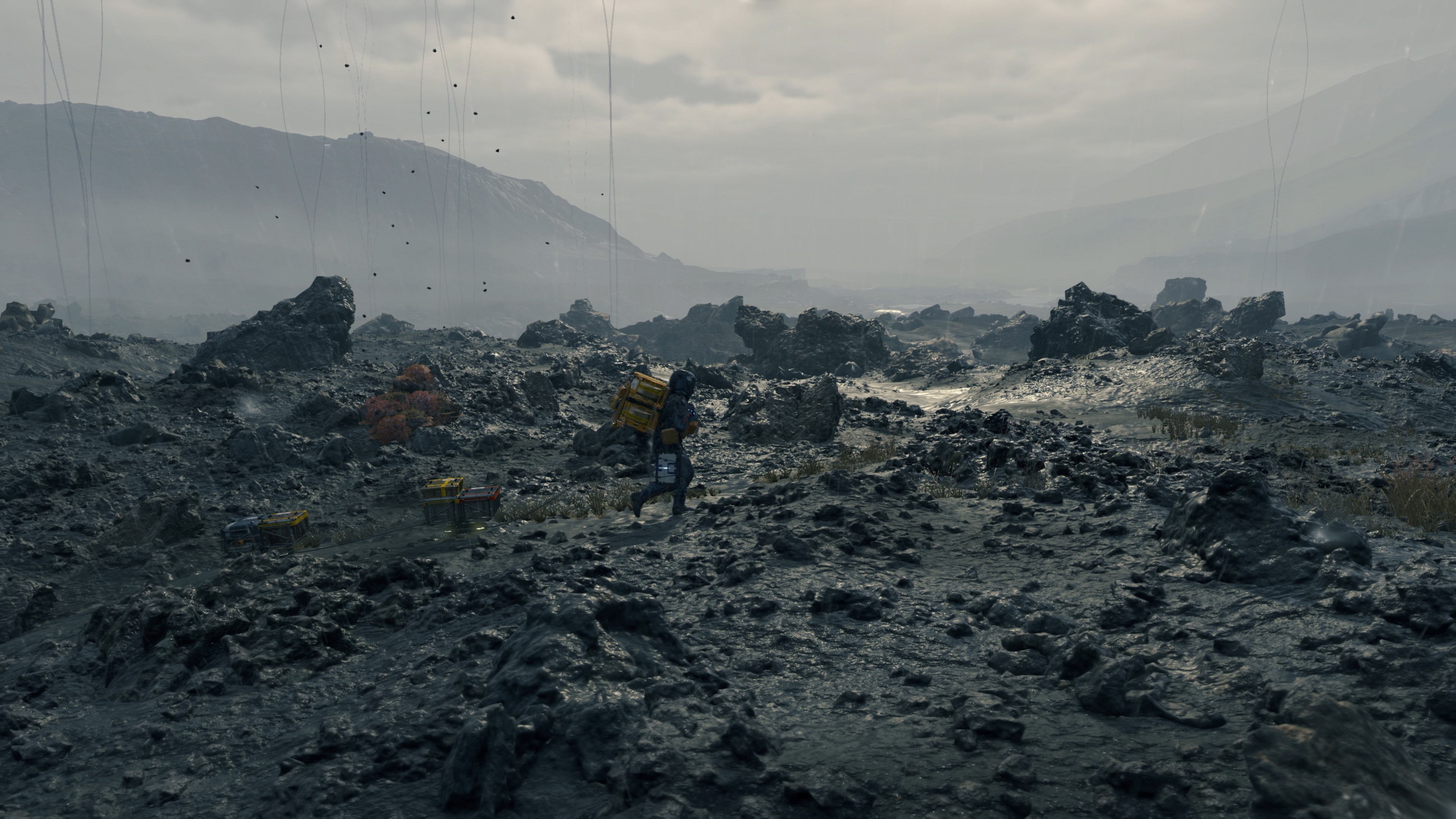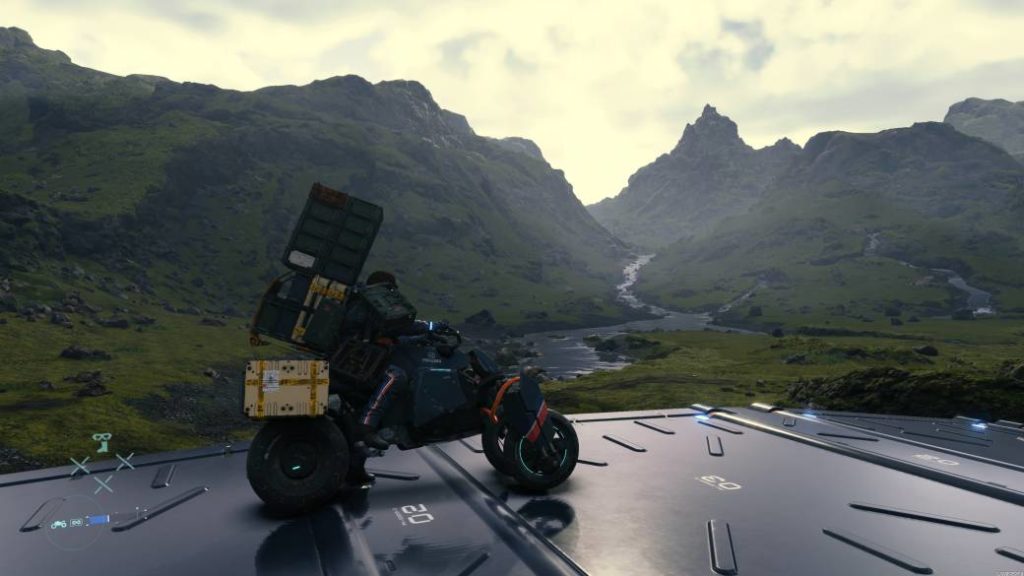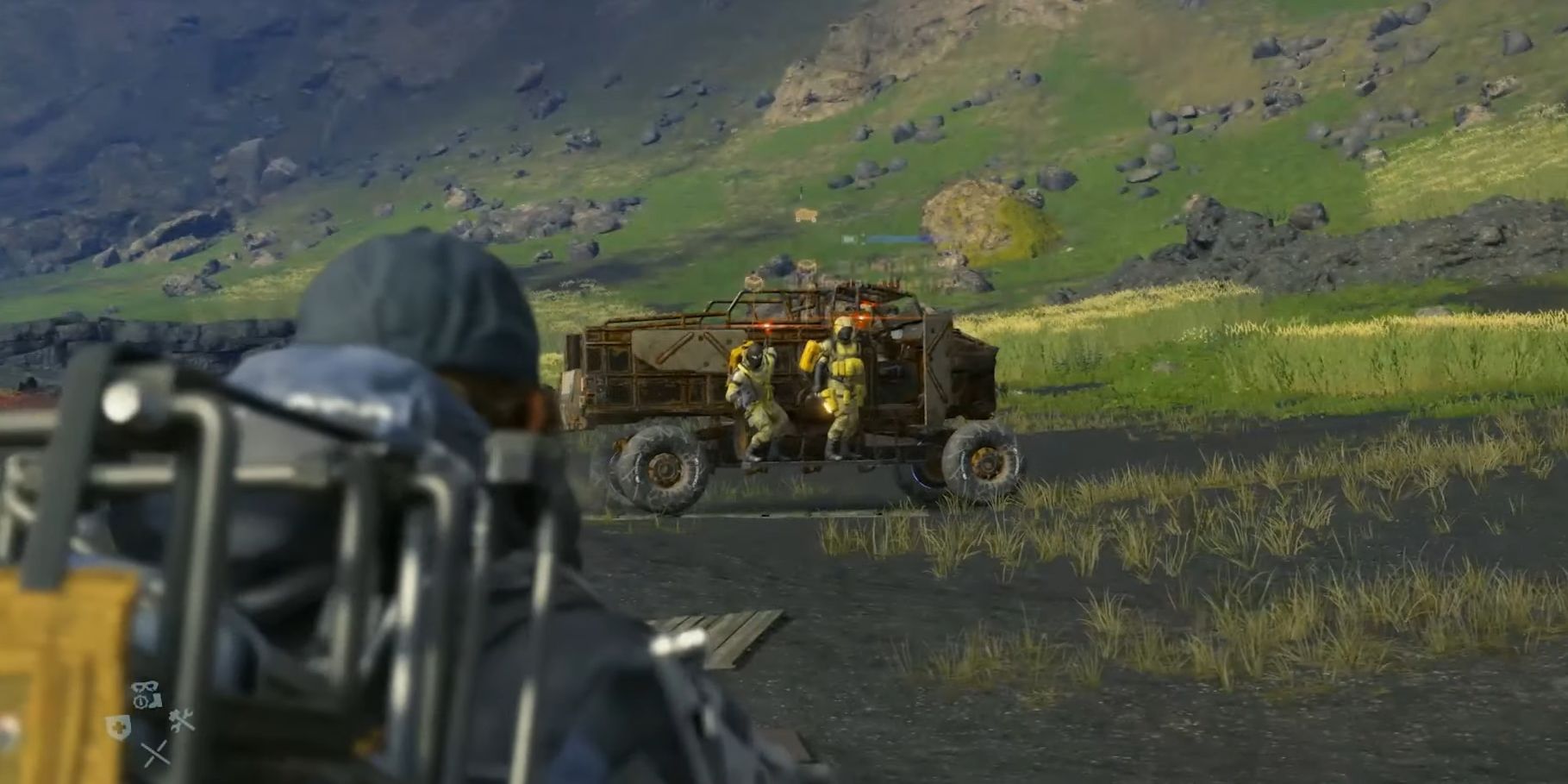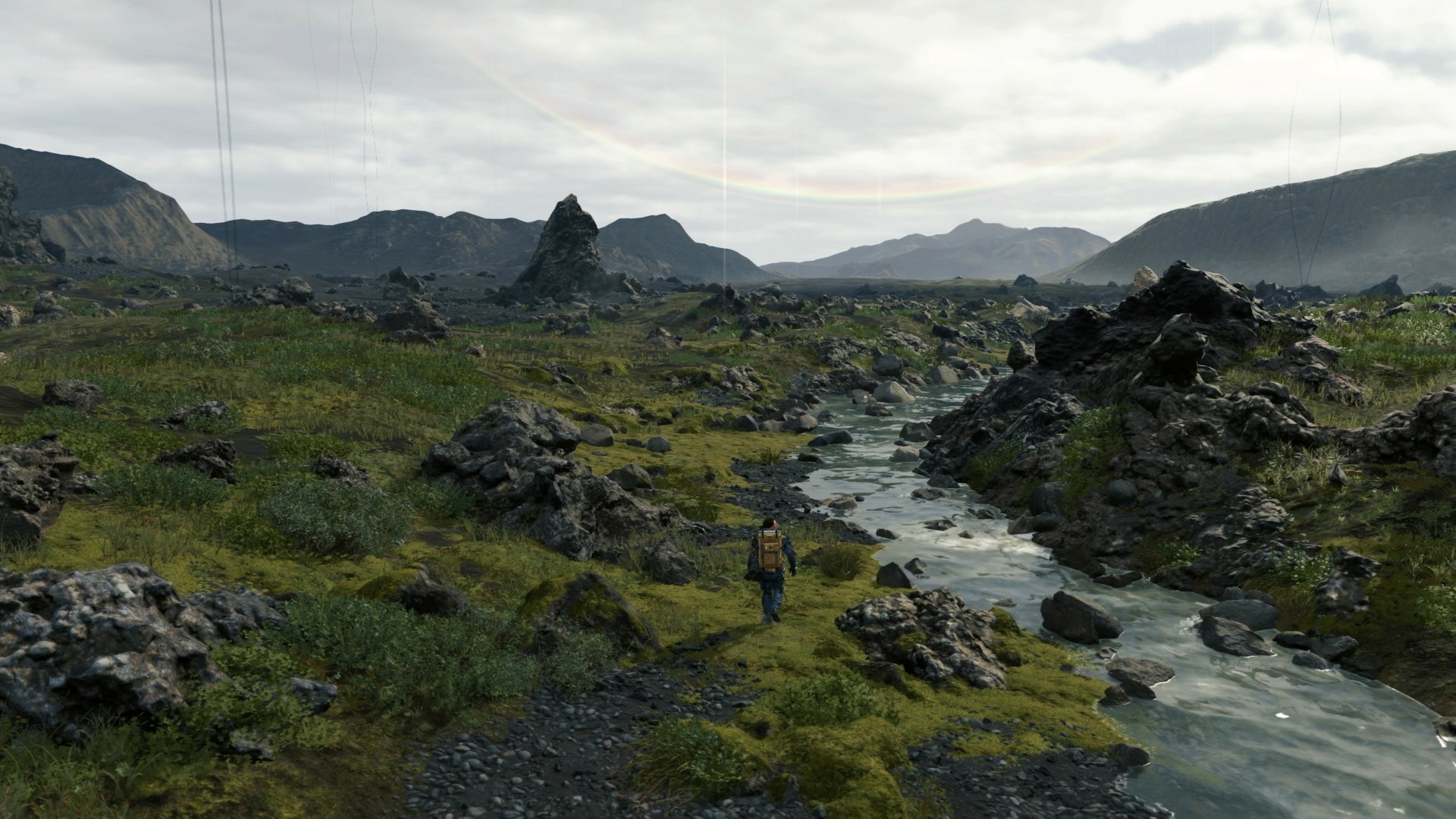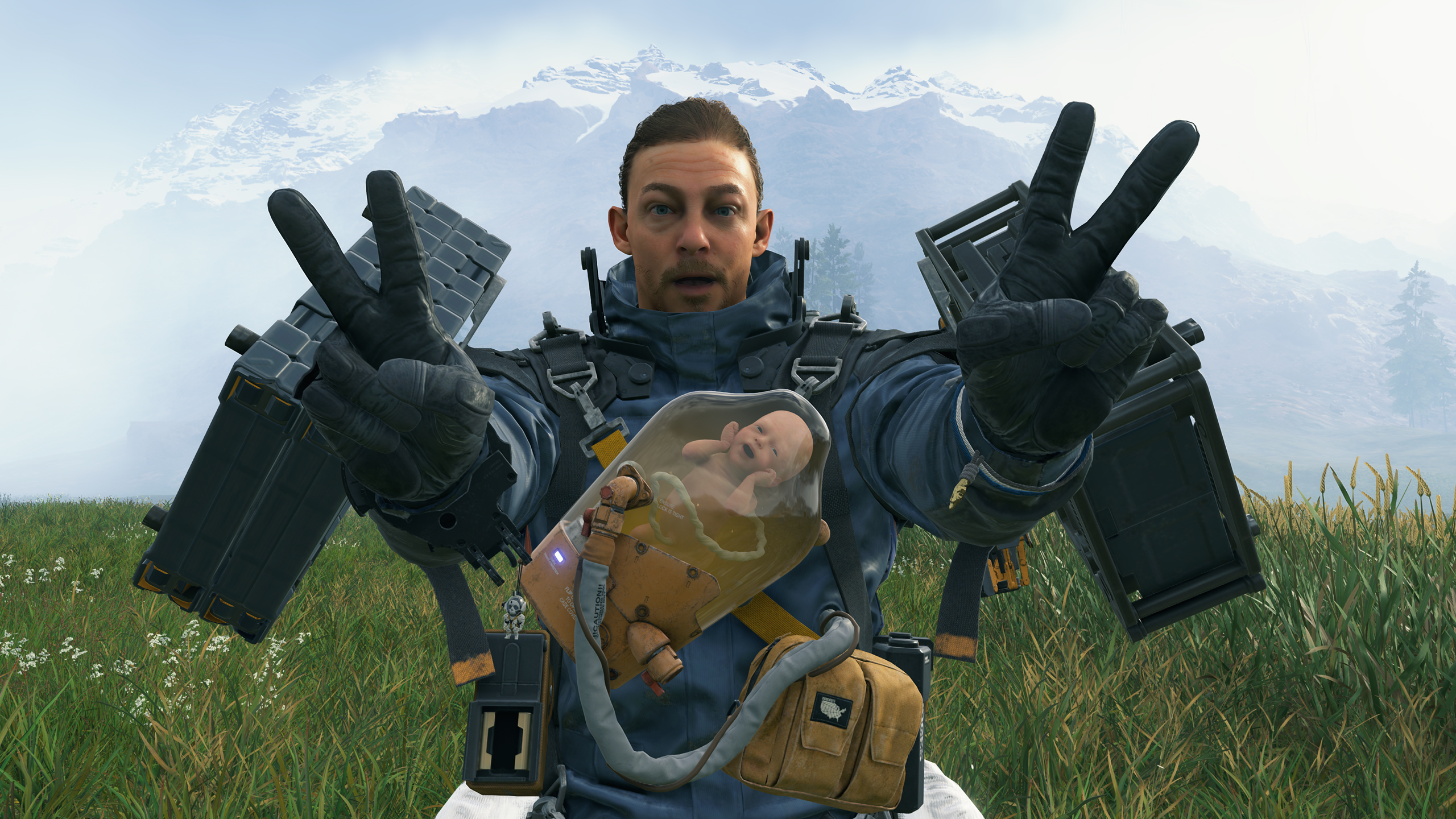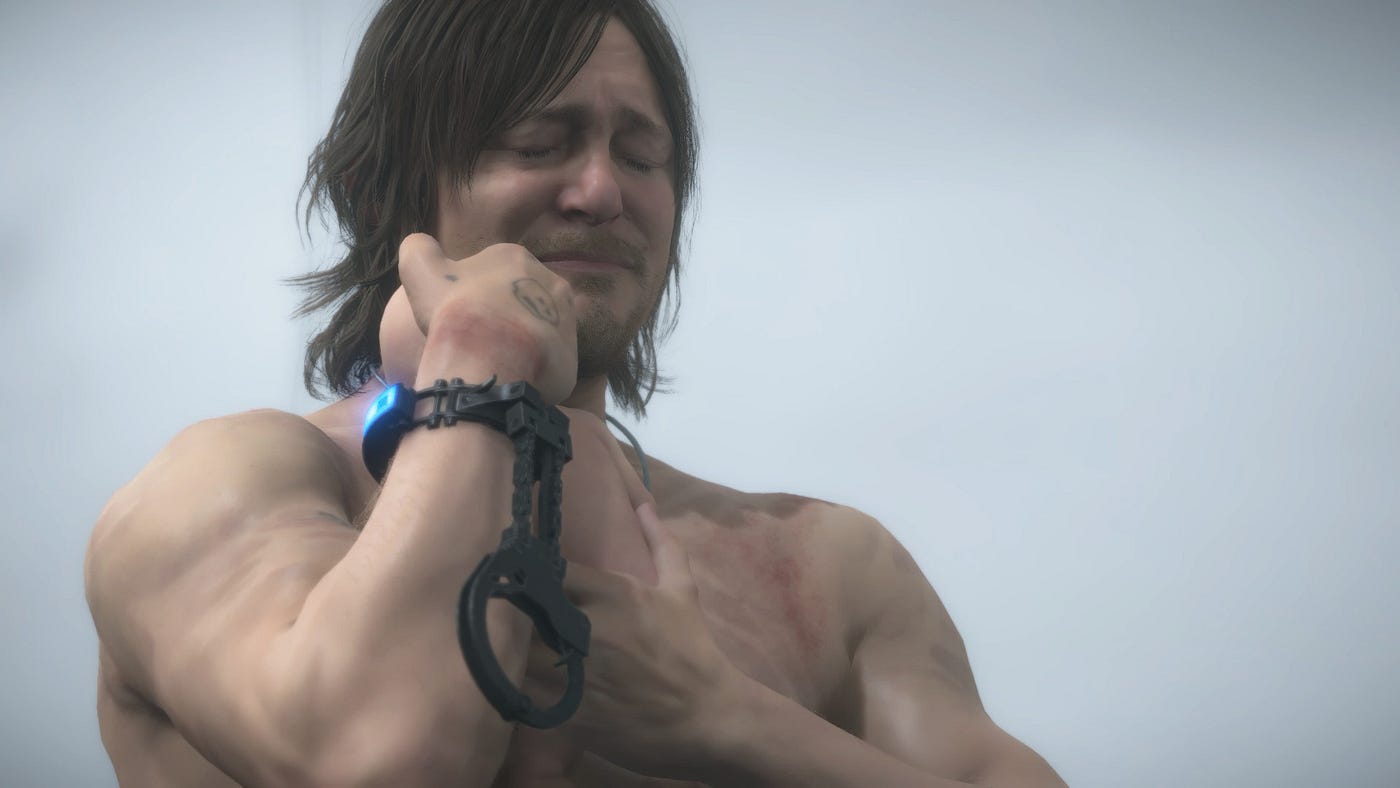The PlayStation Plus revamp cam at just the right time for me. Having come home on a high of seeing Green Day, Fall Out Boy and Weezer all in the same night, I was stricken down by COVID. What followed were a few days molecularly bonded to the Ikea sofa in my living room, unable to go out and see friends, whilst desperately wanting to enjoy the summer weather. Enter Death Stranding…
Now, for those expecting this to be anything like Kojima’s earlier work on the revolutionary Metal Gear Solid series, you might be disappointed, although some aspects have survived the jump. Lengthy cutscenes, dialogue which walks a tight rope between stupid and awesome and plenty of codec calls to fill in the gaps are all present here. However, in place of the tactical espionage action, there is a robust delivery and logistics game. Many people have called this a “delivery simulator” and thrown around some harsh words due to the glacial pace of the adventure, but that is incredibly reductive, and throughout this review I hope to let you know why. Some criticism is well-deserved, and we’ll get to that, but for me, I had a great time with Death Stranding.
I try not to compare this to older Metal Gear titles, but apparently, I can’t help myself. Sorry in advance.
It isn’t about the destination
The story of Death Stranding is a difficult one to sum up. So I’ll do my best, and apologies if the sci-fi jargon gets too much, if it does, I won’t be offended if you skip to the gameplay section. The world of Death Stranding is objectively interesting, you will be faced with many questions, what is with all the dead crabs? Why does that rain rapidly age everything it touches? What causes the ghostly handprints to appear on naked Norman Reedus? It goes on. For the most part, you get these answers, along with a few more questions.
Once again Kojima has captured the imaginations of many and expertly toed the line between incredibly stupid and admittedly smart. There are some truly, truly awful lines of dialogue in here, but they are written with the kind of sincerity which does charm you, and comes from a real place of sincerity. It is hard to explain how the writing simultaneously both under and over explains the plot and concepts at play here, but that is what ends up happening. The main antagonists motivation for example still alludes me after finishing the game and even having some time to reflect on what happened. If you weren’t a fan of the exposition-heavy dialogue of the Metal Gear games, and were put off by the reliance on lengthy cutscenes, Death Stranding will do little to change your mind. As lovely as those cutscenes look.
The narrative begins with Sam Porter-Bridges (yes, his occupation is as a porter, and he does indeed build bridges) as he is tasked with reconnecting the world after a cataclysmic event. You learn about the true nature of that event, but at the start of the game, all you need to know is that humanity is fragmented into various camps across the continent with no means of communicating. Oh, there are also evil ghosts with long umbilical cords – it makes sense in context. As a delivery man, you need to connect the scattered remnants of civilization back together by delivering packages and getting them connected to “The Chiral Network” – a high speed internet, which allows for the sharing of resources, as well as extremely handy 3D printing. Off you go to explore the remains of the USA, which oddly look a lot like Wales.
More intricacies unfold here, but this is the main goal – link the country back together with the help of your eccentric cast of characters, none of which are anywhere near as memorable as the likes of Otocon, but that was always a losing battle.
About the journey
Moment-to-moment gameplay in DS isn’t going to inspire much in spectators, a mission consists by-and-large of taking one or a number of packages from one place to another, traversing treacherous terrain and tackling the many contours of the United States. What at first glance looks like a straight forward gameplay loop of “just keep walking” is actually something a little deeper if you are playing. Players are consistently making micro decisions, surveying the terrain and choosing the safest path across the peaks and valleys to reach your destination. As I was sofa-bound for a few days, this consistent loop of delivering packages was enough to keep me invested, especially with the intriguing story and world building which has been peppered throughout.
No other game has made me deliberate quite so intensely about how I should cross a river, or how I should scale a hillside, but Death Stranding managed to – and I enjoyed it. There is something commendable in that, to make something fairly mundane exciting, it’s something that a game like Phoenix Wright also excels in. The goal of Death Stranding isn’t always to get to your destination as quickly as possible, sometimes it is, but most of the time it is about managing your cargo and getting there safely. An interesting change of pace if you come off the back of something like Doom Eternal.
Sam has several tools to help navigate the harsh wasteland and complete these deliveries, they start out as simple as a ladder to help scale small rock faces or bridge narrow rivers and an anchored rope to allow you to abseil down steep drops safely. Soon however, these tools get much more exciting, catapults to launch your cargo, generators to keep you charged up and ziplines to name but a few. By placing these on your way to your next distribution centre you not only make your return journey much easier, but subsequent deliveries along this route. Set up a network of dangling ropes to scale and that daunting 15-minute hike can be cleared in no time. This is one of the best elements of Death Stranding for me – it was endlessly satisfying to set up an elaborate infrastructure of roads and ziplines around a mountainside and prosper from that hard work later on. I was given 60 minutes to make a delivery up and down a mountain which I was able to clear in under 12. This iterative progress wormed itself into my brain, and I couldn’t get enough.
One criticism that could be lobbied at the game is that this in turn makes the walking redundant, since these structures remove the need to walk everywhere. I would disagree with this statement for the most part as the structures like ziplines can only be placed when you have linked up the area to the Chiral Network, meaning that you must always make the journey alone before receiving this benefit. Once you’re all linked up, you can also see a range of other players’ structures and in turn they can also use yours, this does provide a real sense of community amongst Death Stranding players, but it is unclear as to how each structure is chosen to appear in your world. It was always great to see these little shortcuts populate my world making future deliveries a bit of a doddle, but that release of frustration and hardship was well worth the squeeze for me.
One thing that hasn’t changed from Metal Gear Solid V: The Phantom Pain is the menus being incredibly unfriendly. Gearing up before each mission, whilst interesting it its own right, feels clumsy and awkward. There is a lot of menu management in here, as you’d expect for a game based around logistics, but it was a bit much. The map can also quickly become cluttered, with a cacophony of icons which don’t look too dissimilar to a Ubisoft game. Luckily, I managed to become accustomed to this after a few hours, and I was soon plotting routes with very little friction.
Face to rock-face
The landscape isn’t the only challenge you’ll face in DS though. There are two more threats which are intent on stripping you of your packages and stressing out BB (the small baby strapped to your belly). These are MULEs, corrupted post men who suffer from a condition known as Porter Syndrome and seek primarily to steal the cargo of other, and BTs, invisible beings from the afterlife intent on pulling living creatures through to the other side. Only the latter of which is explained in the story explicitly, to learn about the MULEs you need to dive into the reams of emails you will receive throughout the game, or look it up on Famdom later.
MULE camps are populated with human threats, which once they spot Sam, are relentless in their quest for cargo. They can’t run as fast as Sam, making them much less of a threat, but with their access to vehicles and other projectiles, they can take you out at range. You are able to use weapons of your own to deal with these nuisances, you have a bola gun, non-lethal rifles, smoke grenades, all of which can incapacitate these deranged couriers. The AI of this cult isn’t too great either, simply making a b-line to Sam’s position without a single shred of a plan to capture him – there are no blockades, no teamwork, nothing. This can be explained by their “Porter Syndrome”, unfortunately it makes them far less interesting and intimidating from a gameplay perspective. Ultimately, these feel like a step down from even more primitive Metal Gear titles, which is perhaps remedied by the VR missions they introduced in the Director’s Cut, but I didn’t try them out before writing this review.
BT areas are indicated by a heavy dose of Timefall, and the emergence of your Alderak (the starfish looking thing you see on Sam’s shoulder in most of the promotional material for the game). Here, aided by BB you navigate the invisible monsters through a game of “hotter or colder”, as your baby and paranormal metal detector tell you where not to step. Exploring these areas requires constant use of the crouch button, along with a contextual “hold breath” button should you get too close. If you do alert these spectral landmines, the floor quickly turns to tar, slowing your movement whilst you are swarmed by shadowy figures threatening to pull you and your precious cargo under. It is an exceptional way to create dread and tension in the player, unfortunately it never evolves past this, and in the later portions of the game, serves as more of an annoyance than anything else. I would’ve loved for these BT encounters to vary up a little bit, but the formula remains the same for the entire journey. One later encounter with them does stray from the formula, and it is more memorable for it, this just screams of a missed opportunity to me, and I’d love to see it explored more if we were to ever get a sequel. This being said, the imagery and story beats accompanying the BTs is great, and there isn’t much like it in the games medium to this day.
Accounting for these MULEs and BT areas when saddling up for the journey will make you think twice before setting out. Can you make it through unscathed? Do you want to take a full backpack and risk dropping some precious cargo? It depends on your character, but typically I am very risk averse which managed to keep my close calls to a minimum.
Finally, in true Kojima fashion, you have some bosses sprinkled in. Unfortunately, much like the MULE camps, these feel lesser than antagonists seen in his previous work. It seems unfair to compare bosses in any game to antagonists like Psycho Mantis or The Sorrow, but with such pedigree, it is really hard not to. Despite the games constant urging not to kill, and to play more pacifistically, one of the main recurring boss fights has you doing just that – shooting and murdering on a battlefield. This doesn’t fit Sam’s character so much, especially as you take out military-trained special operatives, as neat as these sections are, I can’t help but think there would be a more interesting way to incorporate a confrontation in a game like this. If anyone was going to pull it off, it’d be Kojima. None of the bosses are outright bad, I just wanted more, and that is on me.
Stunning scenery
The menus and presentation in DS are painted with a semi-futuristic aesthetic, whilst it fits the feel of the general tone of the game, it does nothing to inspire me. From memory, it really isn’t too different from MGSV, but if it works, who am I to complain? The graphical fidelity of the endless moors you will trek across however, are truly exceptional. There has clearly been countless hours poured into the creation of this landscape which feel oddly homely for someone living in the UK. This rendition of the US is essentially a melding of Welsh countryside and the North Yorkshire Moors, and it is bloody gorgeous.
Now is a good time to talk about the soundtrack, whilst a little too subdued for me to listen to in my free time, it is wholly unique and I am always a fan of having lyrics in the music to my video games. This is something that I praised Metal Gear Rising for, and I really am shocked that more games don’t commit to this. I suppose in less talented hands it could come off as a little cheesy, but when it works, it really works.
Each of the main episodes are punctuated with a strong culmination of visual, music and gameplay, and it is when these elements come together that the title is at it’s best. Finally reaching the crest of a hill, seeing your destination, civilization in the distance before making your descent as Low Roar begins to swell is awesome. The frequency of these moments is little enough that they remain special, but often enough that it keeps me engaged and chasing the next high.
I have to spend some time reflecting on the use of motion-capture, use of real actors likeness, and ultimately whether or not I think this was a good call. My opinion hasn’t changed on this topic after playing Death Stranding unfortunately, games aren’t quite there yet I’m afraid, although this is a valiant, and closest attempt to bridge the uncanny valley I have seen. The true acid test of this for me was whether or not I could see Mads Mikkelsen and Troy Baker as characters instead of actors playing characters – unfortunately I could never quite get there. Maybe if I wasn’t already familiar with their work I could see through the photo-realistic face and see Higgs, but this was ironically only possible when he was wearing his mask. It isn’t a deal-breaker by any means, but for Kojima’s future work, I’d hope to see him move away from this. That is never going to happen, but I can dream.
Reflecting on the journey
Whether you enjoy Death Stranding or not will depend entirely on your expectations going in. If you are ready for a much slower paced and more unique take on the third-person action-adventure game, keep your mind open and you might just find something to really love here. If you want another Metal Gear, with action, stealth and exceptional boss battles, maybe leave that at the door.
Death Stranding is a game I won’t play again, but I did thoroughly enjoy my time with it, sometimes I was frustrated trying to scale cliff faces which were a little too steep, but reaching the top was always rewarding after a little tribulation. I would recommend you check it out on your revamped PS Plus if you have it, if not, ensure you are in the right head space before committing to the long journey through the American wasteland.


